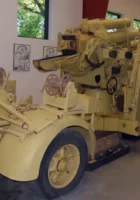
German 88mm FLAK 36 | |
|---|---|
| Country | Germany |
| Type | German 88mm FLAK 36 |
| Period | ww2 |
Album of 69 photos of a German 88mm FLAK 36
Views : 6864
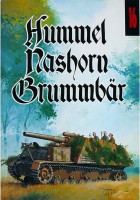
Wydawnictwo Militaria | |
|---|---|
| Serie | Wydawnictwo Militaria |
| Réf | 016 |
| Sujet | Hummel,Nashorn,Brummbar |
| Période | ww2 |
Une documentation signée Wydawnictwo Militaria le livre «Hummel,Nashorn,Brummbar – Wydawnictwo Militaria 016» .
Le Hummel (bourdon en allemand) était un canon automoteur basé sur le châssis du Geschützwagen III/IV, armé d’un obusier de 150 mm. Il fut utilisé par la Wehrmacht au cours de la Seconde Guerre mondiale de la fin 1942 jusqu’à la fin de la guerre. Sa désignation complète était Panzerfeldhaubitze 18M auf Geschützwagen III/IV (Sf) Hummel, Sd.Kfz. 165. Le 27 février 1944, Adolf Hitler ordonna d’abandonner le nom Hummel qu’il trouvait peu approprié pour un véhicule de combat.
Source: Wikipedia
Views : 1360
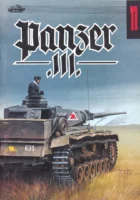
Wydawnictwo Militaria | |
|---|---|
| Series | Wydawnictwo Militaria |
| Réf | 011 |
| Sujet | Panzer III |
| Period | ww2 |
Signed documentation Wydawnictwo Militaria le livre «Panzer III – Military Publishing House 011» .
The Panzerkampfwagen III (PzKpfw III), often abbreviated as Panzer III, was a German tank designed in the late 1930s and used extensively during the first phase of World War II. It was developed to engage enemy armoured vehicles, while the contemporary Panzer IV had been intended to provide support fire to armoured formations. However, with the emergence of increasingly protected Allied tanks, only the Panzer IV was able to ship weapons capable of destroying them, and it supplanted the Panzer III as the main tank of the Wehrmacht.
Source: Panzer III on Wikipedia
Views : 1065
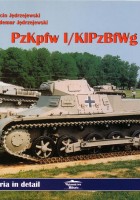
Wydawnictwo Militaria | |
|---|---|
| Series | Wydawnictwo Militaria |
| Réf | 009 |
| Sujet | Panzer I |
| Period | ww2 |
Signed documentation Wydawnictwo Militaria le livre «Panzer I – Military Publishing House 009» .
The Panzer I is a German light tank, designed in the 1930s and used during the Spanish War and the beginning of World War II. It was the first panzer to be made when Germany, following the Treaty of Versailles, had forbidden to study or build armoured vehicles, so that the first designation applied to it to blur the tracks, was well innocuous, Landwirtschaftlicher Schlepper, or agricultural tractor, but later it received a more official Panzerkampfwagen I (armored combat vehicle). It is also known as Sonderkraftfahrzeug 101 (short for SdKfz 101) literally special motor vehicle.
Source: Wikipedia
Views: 490

Wydawnictwo Militaria | |
|---|---|
| Series | Wydawnictwo Militaria |
| Réf | 007 |
| Period | World War II |
| Sujet | PzKpfw 35(t) |
Signed documentation Wydawnictwo Militaria le livre «PzKpfw 35(t) – Wydawnictwo Militaria 007» .
Les Chars LT vz 35 were employed by the Czechoslovak army from 1937 to 1939. But a total of 219 LT vz 35 tanks were captured by Germany in March 1939 and employed by the Wehrmacht during World War II. They were first used, from June 5, 1939, by the cavalry under the name LTM 35. But after January 16, 1940, they fell under the control of the Panzertruppe, the German armored units, under the name Panzer 35(t), the letter t indicating their Czechoslovak origin. The 6th Panzer Division (which at the time was still called the 1st Light Cavalry Division) was equipped with it at the beginning of the war, and the tanks served in Poland in 1939 and in France in 1940. But from 1940, there were no more spare parts and the tanks had to be completely rebuilt to remain operational; it was therefore decided that the campaign of the summer of 1941 would be their last. In addition, Panzer 35(t) proved to be totally inadequate in the face of the extreme cold encountered in the USSR. At the end of November 1941, not a single one was operational. These weaknesses, in addition to the thinness of their armor and the low caliber of their gun against Soviet tanks, meant that most were withdrawn from the front and the 26 still operating in 1942 were sold to Romania. The tank continues to serve another year in Slovakia and Romania. Some are then transformed by Germany into ammunition transporters or tractors.
Source: Wikipedia
Views : 519
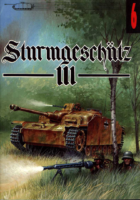
Wydawnictwo Militaria | |
|---|---|
| Series | Wydawnictwo Militaria |
| Réf | 006 |
| Sujet | Sturmgeschutz III |
| Period | ww2 |
Signed documentation Wydawnictwo Militaria the book "Sturmgeschutz III - Wydawnictwo Militaria 006" .
The assault cannon Sturmgeschütz III (StuG III) fut le véhicule blindé de combat produit au plus grand nombre d’exemplaires par l’Allemagne au cours de la Seconde Guerre mondiale. Il était construit sur le châssis du char Panzer III. Conçu au départ comme un canon léger blindé destiné à soutenir l’infanterie, le StuG fut continuellement modifié et fut largement employé comme chasseur de chars. La série des Sturmgeschütz est reconnue pour son excellent rapport prix/qualité. À la fin de la guerre, plus de 10 500 avaient été construits.
Source: Wikipedia
Views : 1120

37mm Pak35-36 | |
|---|---|
| Pays | Germany |
| Type | Anti-tank gun |
| Period | World War II |
Photo gallery on a Pak35-36 cannon, The Pak 36 (Panzerabwehrkanone 36) was a German anti-tank gun capable of firing 37 mm caliber shells. Developed in 1936 by Rheinmetall, the Pak 36 appeared the same year during the Spanish Civil War. It became the base of the anti-tank guns of many countries during the early years of The Second World War. The KwK 36 L45 was the same gun, but served as armament on several battle tanks, including early-war models such as the Panzer III.
Views : 4832
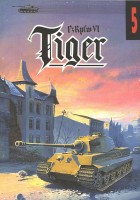
Wydawnictwo Militaria | |
|---|---|
| Series | Wydawnictwo Militaria |
| Réf | 005 |
| Sujet | Panzerkampfwagen VI Tiger |
| Period | ww2 |
Signed documentation Wydawnictwo Militaria le livre «Panzerkampfwagen VI Tiger – Wydawnictwo Militaria 005» .
The Tiger I (Tigre), char d’assaut lourd allemand, en service de 1942 à 1945, est l’un des chars les plus connus de la Seconde Guerre mondiale, bien qu’il n’ait été que peu produit par rapport au T-34 soviétique ou au Sherman américain. Ce sont ses dimensions, ses lignes très carrées, sa résistance au combat, sa puissance ainsi que les équipages expérimentés l’ayant mené au feu qui ont marqué les esprits, notamment du fait de la propagande allemande. Son développement a commencé en 1937 et, quand il apparaît pour la première fois sur le front, le 29 août 1942, près de Léningrad, le Tigre I est le char techniquement le plus avancé, le mieux protégé et le plus puissant aligné par l’Axe, affichant une mobilité limitée mais exceptionnelle pour un engin qui fait plus de deux fois le poids de ses prédécesseurs et de la majorité de ses adversaires chenillés. Mais le char lourd, outre de sa production faible, a pâti tout au long de sa carrière de sa mécanique très fragile réduisant considérablement sa disponibilité au feu, de sa mise en œuvre opérationnelle rendue difficile par sa faible autonomie, souffrant également de son poids excessif. Construit à seulement 1 350 exemplaires, il n’a été que rarement endivisionné mais plutôt engagé dans des unités indépendantes.
Source: Wikipedia
Views: 601

Wydawnictwo Militaria | |
|---|---|
| Series | Wydawnictwo Militaria |
| Réf | 004 |
| Period | World War II |
| Sujet | Panzer IV |
Signed documentation Wydawnictwo Militaria the book "Panzer IV - Wydawnictwo Militaria 004" .
The Panzerkampfwagen IV (PzKpfW IV), often referred to as Panzer IV was a tank used by Nazi Germany during World War II. Originally designed as a fire support tank, with a short 75 mm gun, for the Panzerkampfwagen III, it eventually replaced the panzerkampfwagen III when allied tanks became too protected for the pan. Re-equipped with a long anti-tank gun, the PzKpfW IV was the main German tank during the second part of the war with more than 9000 copies produced and gave birth to many versions.
Source: Wikipedia
Views : 647
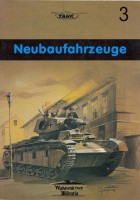
Wydawnictwo Militaria | |
|---|---|
| Series | Wydawnictwo Militaria |
| Réf | 003 |
| Sujet | Neubaufahrzeug |
| Period | ww2 |
Signed documentation Wydawnictwo Militaria le livre «Neubaufahrzeug – Military Publishing House 003» .
The german prototype series Neubaufahrzeug was a first attempt to create a heavy tank for the Wehrmacht, after Adolf Hitler came to power. Multi-turrets, heavy and slow, these tanks did not fit with the tactics of the Blitzkrieg and were not put into production. They were mainly used for propaganda purposes, although three took part in the Norwegian campaign in 1940.
Source: Neubaufahrzeug on Wikipedia
Views : 676